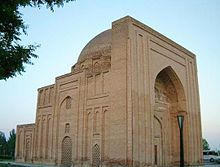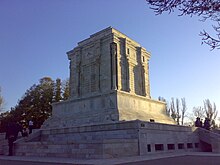Tus, Iran


Tus (Persian: توس or طوس) also spelled as Tous, Toos or Tūs, is an ancient city in the Iranian province of Razavi Khorasan, near Mashhad. To the ancient Greeks, it was known as Susia (Ancient Greek: Σούσια). It was captured by Alexander the Great in 330 BCE.
On his way to solve the unrest in Khorasan in 809, the Abbasid Caliph Harun Al-Rashid fell ill and died in Tus.[1]
The city was almost entirely destroyed by Genghis Khan's Mongol conquest during 1220-1259.
Perhaps the most famous resident was the poet Ferdowsi, author of the Persian epic Shahnameh. His mausoleum, built in 1934 in time for the millennium of his birth, dominates the town.
Some other notable residents of Toos include: Jābir ibn Hayyān, Asadi Tusi, Nizam al-Mulk, al-Ghazali, Nasir al-Din al-Tusi and the prominent Shia scholar Abu Ja'far Tusi.
See also
- Al-Tusi (disambiguation) - scholars associated with Tus
References
- ^ The Court of the Caliphs by Hugh N Kennedy (ISBN 0 297 83000 7)
External links
![]() Media related to Tus, Iran at Wikimedia Commons
Media related to Tus, Iran at Wikimedia Commons
